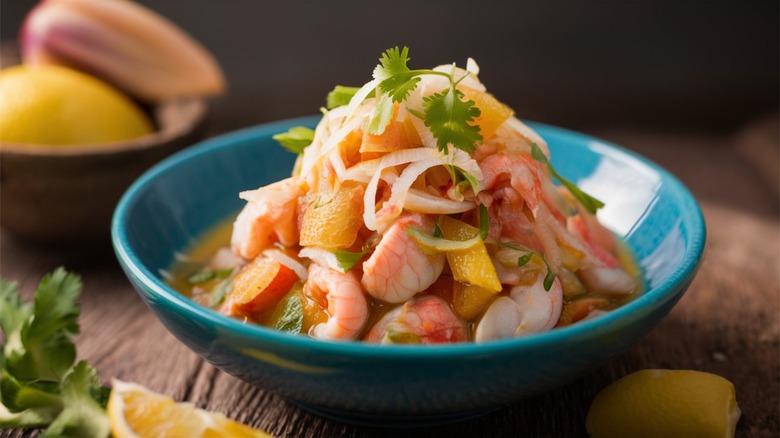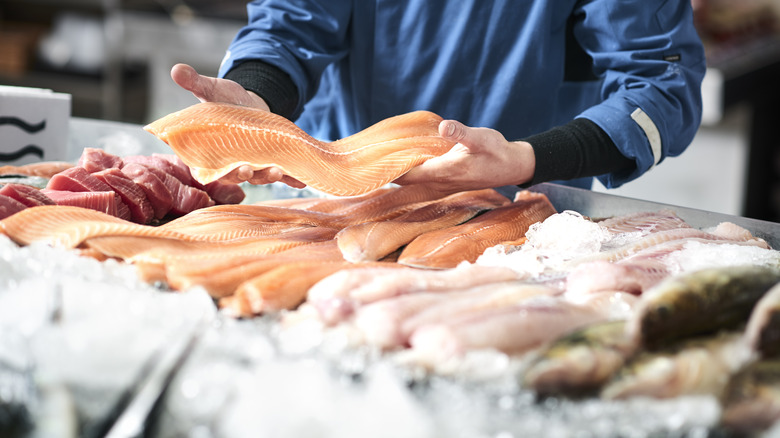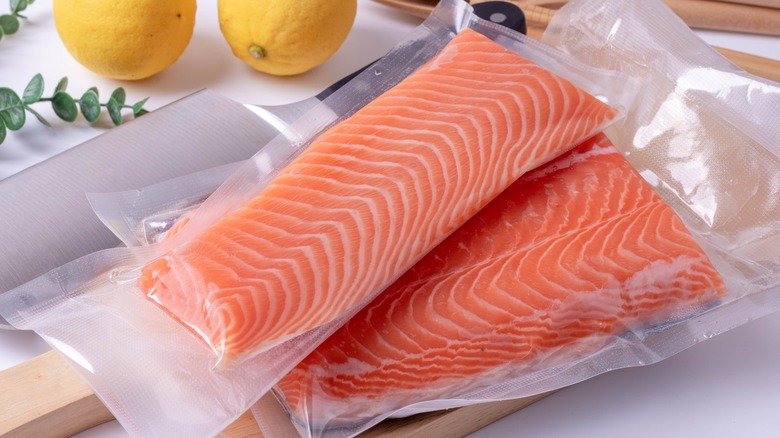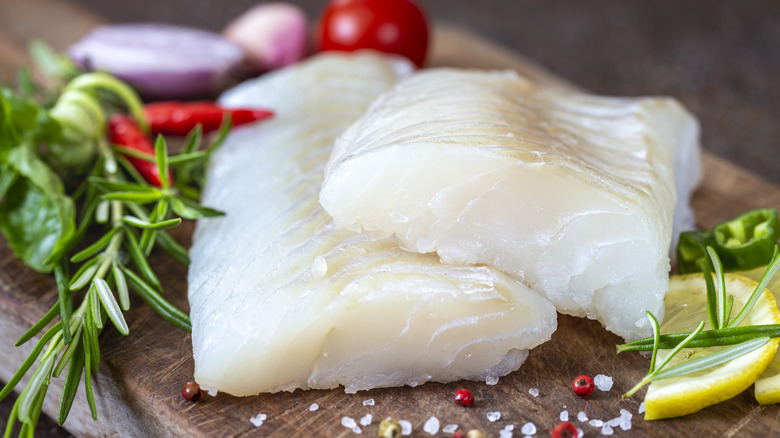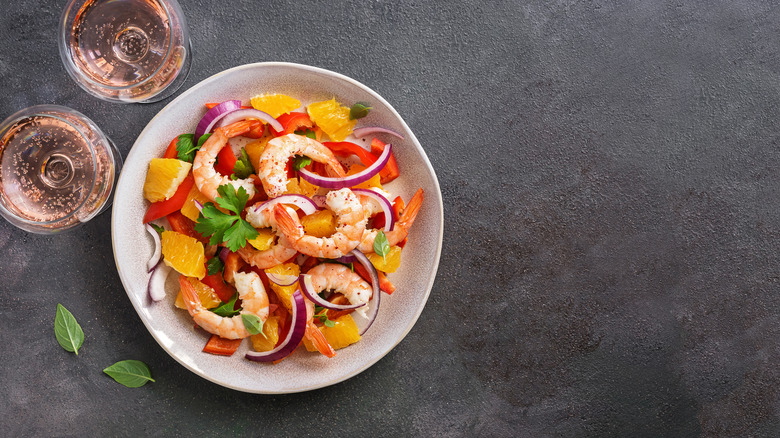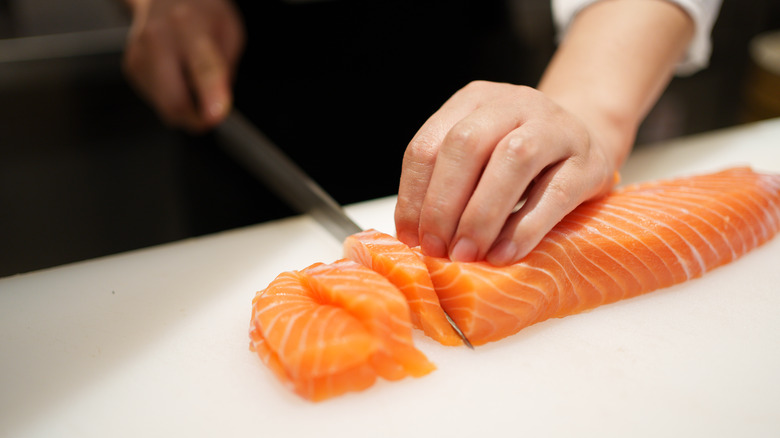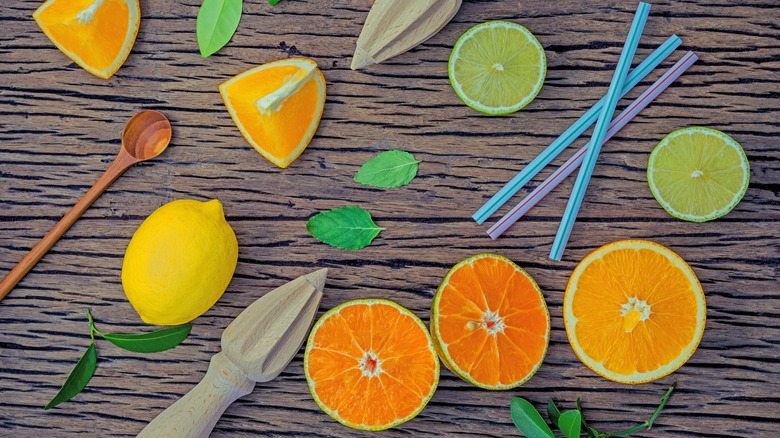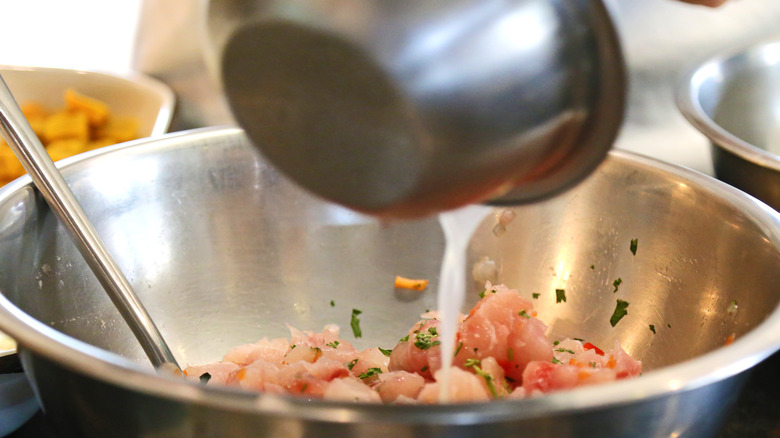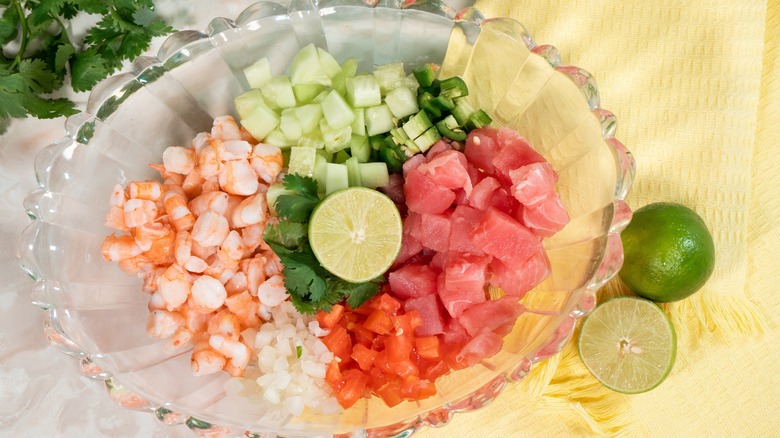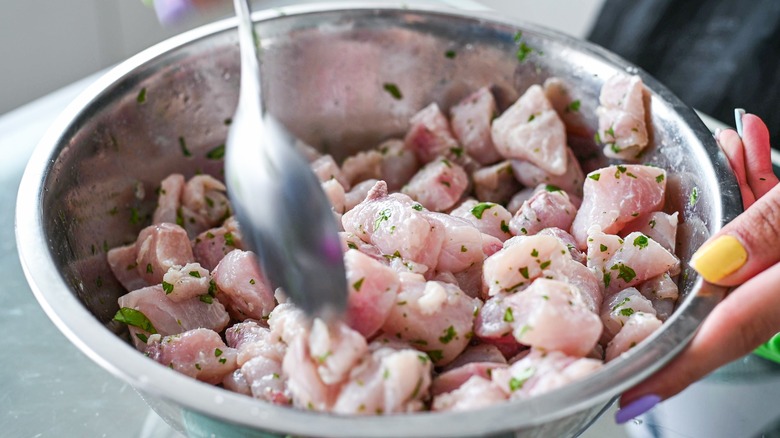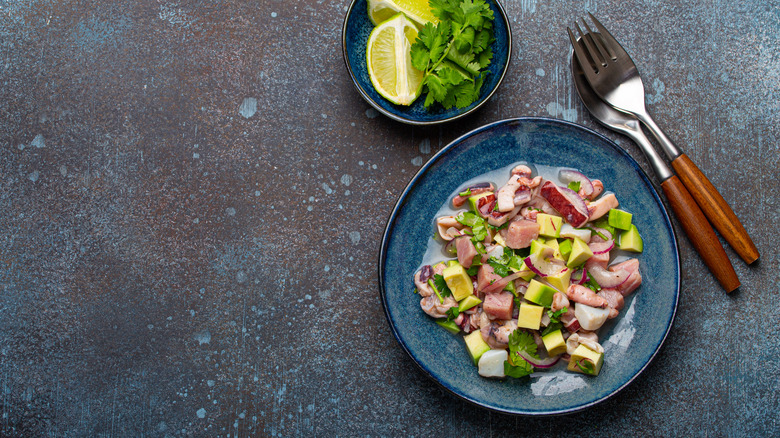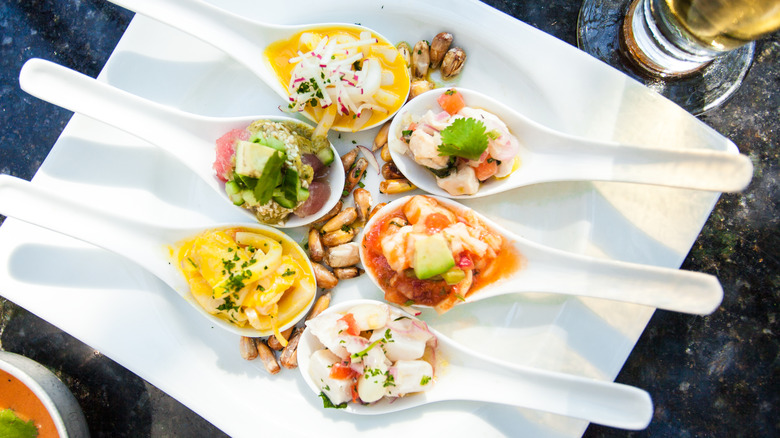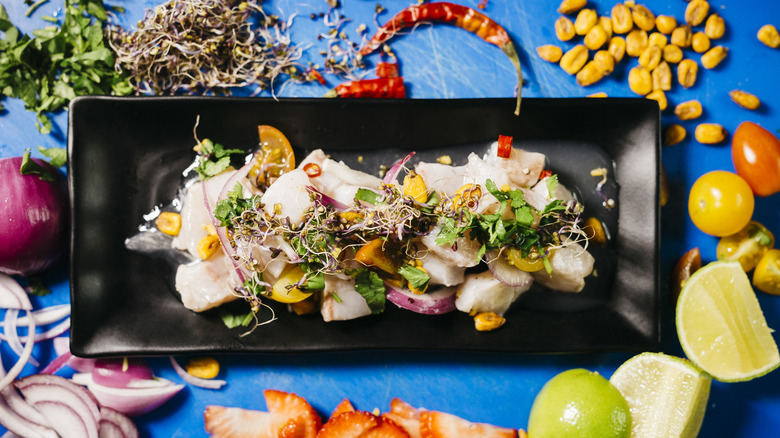Why Ceviche Always Tastes Better At A Restaurant Vs At Home, According To A Professional Chef
Raw seafood is a delicacy in cultures across the globe. From tartare to sushi to poke, uncooked fish is regularly transformed into a dish that's both tasty and reflective of the distinct culinary heritage of a country. One such dish that's commonly found in South American countries is ceviche. While it begins with raw seafood, the fish in ceviche is, in fact, "cooked" (or "pseudo-cooked") using the magical properties of an acidic ingredient. Though you can produce a tasty and safe-to-eat ceviche at home, it's seldom as flavorful and tender as the kind you might enjoy when dining at a fine restaurant.
It's no secret that restaurant chefs have an advantage over home cooks in many regards, particularly when it comes to cooking more complex dishes, like ceviche. Though ceviche isn't particularly difficult to execute, there are some important considerations to be made, and pitfalls that need to be avoided, to create a version worthy of being served by a five-star restaurant. To unlock the restaurant secrets to ceviche, you need a guide who has worked in a professional setting. That's where I come in. With nearly 18 years of experience as a chef, I know a thing or two about what makes ceviche taste so much better at a restaurant. I'm here to help you learn these tricks of the trade and illuminate the many ways you can use them to up your ceviche game.
They buy high-quality fish and seafood
When it comes to sourcing ingredients, restaurants have access to high-quality purveyors most home cooks could only dream of. This is doubly true when it comes to seafood. Accessing fresh seafood is something that can be a challenge unless you happen to live in a coastal town and can get fish straight from the source. That said, many restaurants can and do get deliveries of fresh seafood regularly, that have been flown in that day or were flash-frozen immediately upon being caught.
What's more, restaurants can order precisely what they want and aren't afraid of paying a premium for it, which is a great advantage when trying to produce something as delicate as ceviche. Restaurants can choose seafood that has been wild-caught or farmed, depending on which they prefer, and they are capable of obtaining fish that's sustainably sourced — something that more and more consumers are concerned with.
Lastly, chefs know exactly what to look for when it comes to freshness. They use all of their senses to inspect deliveries meticulously, scouring for any red flags that may indicate that the seafood is past its prime. If they notice an overtly fishy smell, cloudy eyes, subpar packaging, or any indication that flash-frozen fish may have been thawed along the way, they will reject a delivery.
They store the fish and seafood safely
Properly storing fresh seafood on ice is as important as obtaining it, and restaurants take great care in maintaining meticulously sourced seafood, knowing that this step can make or break a dish. As I mentioned, flash-frozen fish is, in many cases, as desirable as seafood that has just been caught that day and gone from the water straight to your plate. Restaurants know this and will often opt to purchase flash-frozen fish because it can be transported safely and transferred straight to the freezer for use when they are ready to prepare a particular dish. Fun fact: most of the fish sold at the grocery store as "fresh" was actually flash-frozen and thawed, so don't let those pesky labels fool you into thinking you're purchasing something that was caught today.
Speaking of thawing, restaurants also know how to safely thaw flash-frozen fish. This fish is typically vacuum-sealed for freshness, which prevents exposure to the elements and contaminants and preserves premium flavor and texture. While this vacuum packaging is highly effective, it's not designed to remain intact when the seafood is thawed, and doing so can be downright deadly, potentially resulting in a C. botulinum infection. This packaging should be removed before allowing seafood to thaw in the refrigerator before use. My rule of thumb is to thaw seafood immediately before using it. I never store previously frozen fish in the refrigerator for more than a few hours after thawing.
They know which types of fish and shellfish work best
When it comes to ceviche, the possibilities are virtually endless in terms of what kinds of seafood you can use. Most restaurants will look at what is fresh and go from there. Others are more discerning, only using certain types of fish that they know can deliver tried-and-true results.
Among the most important factors chefs take into consideration when selecting a particular fish for ceviche is the texture. Semi-firm or firm-fleshed fish and shellfish are always preferred. These tend to maintain their shape and texture after undergoing the acidulated "cooking" process, without becoming mushy or mealy. Chefs also tend to opt for seafood that has a mild flavor and is not oily, which can readily absorb the acidic marinade and other flavor added to the ceviche. That said, if you've ever consumed a salmon ceviche, you know that this criteria may be thoroughly subjective.
Lastly, there's a commonly held belief that you should only use saltwater fish for ceviche, rather than freshwater varieties. Freshwater fish are considered more susceptible to harboring various parasites that can easily be transferred to humans if they are not fully cooked, as in ceviche. Some chefs believe that if the fish is properly frozen and safely handled, it can be consumed in ceviche. For this reason, you may find freshwater fish ceviche on a restaurant menu, though I would recommend against using it if you're making ceviche at home.
They know how to prepare shellfish properly
It can be perfectly safe to use fresh, raw shrimp or scallops in ceviche. This is frequently done successfully, particularly when executed by an experienced chef who is capable of obtaining extremely fresh shellfish and knows how long to marinate it for safe consumption. That said, there are a few caveats when using shellfish for ceviche.
First, shrimp should always be deveined. The dark vein that runs along the length of the back of a shrimp, is its digestive tract. While not dangerous to consume, when this is not removed, the result can be shrimp that have an oddly sandy texture and an off flavor. This can taint even the most flavorful ceviche marinade. Though shrimp can be obtained already peeled and deveined, restaurants will often purchase those that still have their shells intact, opting to remove the veins in-house to guarantee the entire vein is properly removed before the seafood is used. Before being used in ceviche, shrimp may occasionally be parboiled to expedite the curing process and ensure the shellfish is safe to consume. The key is not to overcook the shrimp, which can result in a rubbery texture and a failure of the shrimp to absorb the ceviche marinade.
Where scallops are concerned, while large sea scallops are delightful for pan-searing, dainty bay scallops are typically a better bet for ceviche. They are often sweeter and more tender, and they will "cook" faster than their larger cousins.
They know how to properly cut the fish
The process of cutting fish for ceviche may seem easy enough, but there are some definite pitfalls that can result in ceviche that has a less-than-pleasant mouthfeel. When it comes to processing seafood from whole filets to bite-sized pieces, chefs have the education and experience to execute this quickly and flawlessly — something home cooks may not be quite as adept at. First, fish being used for ceviche must be properly cleaned. This involves eliminating the skin, bones, sinew, and any bloodlines present, to obtain a ready-to-cut filet of fish. Obviously a sharp knife is essential, as is maintaining the fish at a cold enough temperature that will render it easy to manipulate.
Once you've broken down a whole fish into a filet, it's important to slice the fish against the grain. This means that you are cutting in the opposite direction of the muscle fibers of the fish. These should be fairly simple to identify in a raw piece of fish. The reason you want to do this is to shorten these muscle fibers, making the meat easier to chew without giving your jaw a workout. After the initial slices are made, the fish can be cubed into smaller pieces, roughly ¼ to ½ inch in size. If the knife begins to get gunked up along the way, it's important to clean it between slices to maintain a solid, even cube shape.
They use fresh citrus juice
As we have already established, the key to ceviche is how it's transformed by an acid, typically fresh citrus juice of some kind. The magic lies in the way this acid "cooks" the seafood. Whether heated or cured in an acid, protein strands within seafood are subjected to chemical reactions that dissolve the hydrogen bonds linking protein molecules. When these bonds are disrupted, they cause the protein strands to unfurl into new shapes, which results in the fish becoming denser and non-translucent. This process, known as denaturing, is what renders ceviche so delectable.
The type of acid used in ceviche may vary, but chefs have two hard and fast rules — it should be fresh and there should be enough of it to completely submerge the seafood being used. Because the acid both "cooks" and flavors the ceviche, it can be helpful to get creative with various different types of citrus juices, such as grapefruit, sour oranges, or even yuzu, a Japanese citrus fruit with notes of lemon and grapefruit. Though not traditional, other acids may also be incorporated by chefs for complexity, including ingredients like rice vinegar, which has a flavor profile that lends a hint of sweetness to the ceviche marinade.
They know the sweet spot for how long to marinate the seafood
One key factor to making the perfect ceviche, that chefs understand intimately, is that there's a sweet spot for how long the seafood should be marinated. To understand how this works, it may be helpful to compare the curing process that the fish undergoes to what happens to meat when it's cooked. A medium-rare steak that has been properly rested will retain its moistness as those juices redistribute back into the center of the cut of meat. If, however, the meat is allowed to cook any further, any moisture within the meat will eventually be squeezed out of the steak, rendering it tough and practically inedible. Though the method of preparing the fish may be different, employing acid versus heat, the result is the same.
While some shellfish, like raw shrimp or scallops, may require somewhat longer to denature and "cook," most fish used for ceviche requires a relatively short period of time marinating — around 20-30 minutes or so — to reach the ideal doneness. Beyond this, the fish can become overly dehydrated and toothsome, losing that delicate texture that makes ceviche so desirable. Chefs are so attuned to this that they can tailor each recipe to accommodate the precise fish selected, adjusting the marination time accordingly, which takes a keen eye and depth of knowledge about the exact properties of any given type of seafood.
They know what the best ingredients are
Though Peruvians can be credited with inventing the modern-day iteration of ceviche often found on restaurant menus, this dish can be found in countries across Central and South America, and beyond. Every permutation of ceviche tells a tale of the culinary history of the specific country of origin. While the basic ingredients remain the same, fresh seafood and an acid, the precise combination of other ingredients added reflects local sensibilities, ranging from onions and cilantro to peppers, corn, and even peanuts. This makes ceviche a blank canvas for professional chefs to flex their creative muscles, implementing the freshest locally sourced ingredients put together in unique combinations.
One thing chefs excel at is the capacity to layer flavors and textures. Not only will they understand the distinct virtues of a particular type of seafood, they can amplify these characteristics by using various ingredients that provide contrasts in texture, color, and aroma. For example, they may opt to use bolder herbs and spicier chiles with stronger-flavored fish, like salmon, while they will lean toward more subtle flavors when featuring a delicate white fish, like sea bass. This will extend to how the ceviche is served, as an appetizer with chips, as a filling for a street taco, or as the star of a dynamite salad.
They know the best proportion of fish to other ingredients
Not only do professional chefs have a leg up on understanding how to balance flavors on the palate, factoring in elements that feature sweet, salty, sour, bitter, and umami notes, they know how to keep all of these in proportion to one another. Ceviche is, at its heart, a dish that features fresh seafood. The fish or shellfish needs to be the star of the show, with the acid and other elements accentuating the seafood. This means that there is such a thing as too many elements competing for attention.
Most recipes for ceviche feature less than half a dozen elements beyond the fresh seafood and acid. These ingredients are incorporated with a measured hand, keeping in mind that they shouldn't overwhelm the fish, but rather help to showcase it. Additionally, a chef will never marinate the seafood without first tasting it to ensure that the flavors are well-balanced and perfectly seasoned before they are added to the fish or shellfish.
They don't use plastic or metal bowls
Another factor that can make or break a ceviche is the mixing bowl in which it is marinated. Certain types of metals, like aluminum and copper, are reactive, meaning they can interact with the acidic ingredients in the marinade, causing the ceviche to discolor and take on a metallic flavor. Plastic mixing bowls may not react with an acidic marinade, but they're notorious for absorbing aromas that are not easily removed, even if thoroughly washed and sanitized. These lingering aromas can readily transfer to the delicate fish, irreparably impacting the final dish.
Restaurants avoid these issues by stocking their kitchens with commercial cookware, which is typically made from durable, non-reactive, and heat-tolerant stainless steel. They may also employ glass or ceramic mixing bowls for the purposes of making ceviche, which are both great options, not just because they won't adversely impact the flavor or color of the ceviche, but because they can go straight from the kitchen to the table without the need to transfer the finished dish to another serving platter.
They serve it immediately
We already know that there's a sweet spot for marinating ceviche well. Once this has been reached, it's imperative that the ceviche be served fresh, for the best quality. For this reason, restaurants make ceviche daily, doling out portions until they run out, and not saving leftovers for another day. Though the ceviche itself should be served at room temperature, so that the flavors can be most thoroughly savored, it is best to chill the serving vessels the ceviche is plated in. Freshly made ceviche should not be kept at room temperature for longer than two hours for safety and quality.
If you happen to have more ceviche than you can use, you can store it, but certain precautions should be followed. Regardless of how meticulously you strain any excess marinade off the seafood, the fish or shellfish will continue to cure, causing the proteins to denature even further and eventually render the ceviche on the mushy side. The strained seafood should be transferred to an airtight container and transferred to the refrigerator, where it can be stored for about two days before it should be discarded.
They garnish it properly
The final step a restaurant takes when preparing a dish is plating and garnishing it before it's presented to dining guests. This, in many ways, is the most important step, as people eat with their eyes and noses before they ever take the first bite of something. While I already mentioned using a chilled serving vessel for ceviche, garnishing it properly is a game changer. Certainly, some fresh herbs can brighten up a ceviche dish, but if you want to go the authentic Peruvian route, garnish it with sweet potatoes, choclo (a type of large kernel, starchy sweet corn that is boiled and served on the cob), or a toasted corn snack called cancha, made from a type of corn known as maiz chulpe, that reassembles a kind of sophisticated corn nut.
Then come the accompaniments, among which tortilla chips, tostadas, or plantain chips are commonplace, though rice or even toast points can be used to scoop up the marinated fresh seafood. Myself, I'm always seeking to pair any dish with the correct libation to highlight it. If you're like me, and you want to feature a Peruvian classic, a pisco sour is always a great option. Other good pairings include a crisp, acidic, white wine, like a Sauvignon Blanc or a Pinot Grigio.
